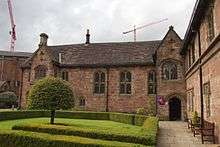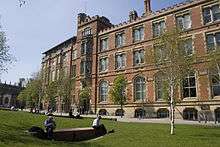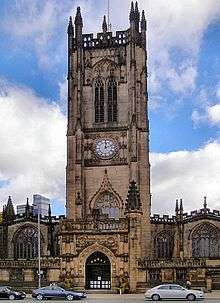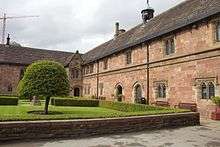Chetham's School of Music
 Main courtyard | |
| Established | 1969 |
|---|---|
| Type | Independent school |
| Head | Alun Jones |
| Chair of Governors | Malcolm Edge |
| Location |
Long Millgate Manchester Greater Manchester M3 1SB England |
| Local authority | Manchester |
| DfE URN | 105588 Tables |
| Students | 290 |
| Gender | Mixed |
| Ages | 8–18 |
| Houses | Victoria, Boys, Girls |
| Website |
chethamsschoolofmusic |
Chetham's School of Music (/ˈtʃiːtəmz/) is an independent co-educational music school in Manchester, England. Chetham's educates students between the ages of 8 and 18, all of whom enter via musical auditions. Students receive a full academic education alongside specialist group and individual music tuition.
Chetham's offers a year-round programme of concerts at the school, Manchester Cathedral, the Royal Northern College of Music, Band on the Wall and Bridgewater Hall. Recitals also take place in churches and community spaces, at festivals and internationally. Its senior ensembles, Chetham's Symphony Orchestra and Big Band, alongside many individual students, have won awards for their music, and many alumni have progressed to highly successful careers as professional musicians or in other sectors.
The music school was established in 1969 from Chetham's Hospital School, founded as a charity school by Humphrey Chetham in 1653. After becoming a boys' grammar school in 1952, the school turned to music as its speciality, at the same time becoming an independent school and accepting its first female students. There are approximately 300 students on roll, including a large sixth form making up around half of the school. Approximately two-thirds of students board on site, with others travelling in as day students from around Greater Manchester. The oldest parts of the school date to the 1420s, when the building was constructed as a residence for priests of the church which is now Manchester Cathedral. These parts are listed buildings housing Chetham's Library, the oldest free public reference library in the English-speaking world.
Academic and music teaching moved into a new, purpose-designed building in 2012; this replaced the Victorian Palatine building and allowed easier access for concert visitors. A 482-seat concert hall, Stoller Hall, opened within the new school building in 2017 as a home for both school and professional music and other genres of performance.
History
Beginnings
The school is built on the site of Manchester Castle, a fortified manor house owned by the Grelleys after the Norman Conquest, at the confluence of the River Irwell and the River Irk.[1] Medieval Manchester grew around the manor house and the parish church, which eventually became Manchester Cathedral.[2]
In the early 14th century, the de la Warre family acquired the land through marriage. Thomas de la Warre refounded the church as a collegiate church in 1421.[3] De la Warre gave the site of his manor house for the construction of a college,[4] where eight priests, four clerks and six lay choristers lived in the care of a warden.[5] It is likely that building began between 1424 and 1429,[6] and the main hall and cloister rooms finished by 1458.[7] It remains the most complete building of its kind in the country,[2] and at the time of its construction, was the second largest building in Manchester, surpassed only by the church.[6]
The college was dissolved during the English Reformation in 1547, and purchased by Edward Stanley, 3rd Earl of Derby.[8] It was re-founded by Queen Mary, before Elizabeth I refounded it as 'Christ's College' in 1578. This arrangement lasted until the foundation of Manchester Cathedral in 1847.[9] The college buildings remained the property of the Stanleys, and wardens (including the Elizabethan astronomer and mathematician John Dee) lived on the premises with their families and servants.[10] During the English Civil War, the college was used as a gunpowder factory and a prison and was left damaged by powder, disused and overrun by pigs. Lord James Stanley, a Royalist, was executed in 1651, and Parliament confiscated his property, including the college.[11]
Humphrey Chetham

Humphrey Chetham (1580–1653) was an unmarried and childless financier, philanthropist and cloth merchant from Manchester. In the 1640s he provided money for the maintenance and education of fourteen poor boys from Manchester, six from Salford, and two from Droylsden.[12] In March 1649 he wrote to the Earl of Derby about his intention to establish a school. He attempted unsuccessfully to acquire the buildings, which were "spoyld and ruin'd and become like a dunghill", to provide a hospital, school and library.[12][13] In his will, Chetham left over £8,000 from his estate (which was worth about £14,000 in total) to establish a hospital school for 40 poor local boys, between the ages of six and ten and from "honest" families, who should be taught and cared for until they were 14.[14][14][15] His executors obtained the lease of the college in 1654 to house both the school and library.[16]
Charity school
After repairs to the college were completed in mid-1656, the first admissions were made.[17] The first headmaster, Richard Dutton, was appointed in 1655,[18] and in 1665 the institution became an incorporated charity.[19] The number of pupils grew, with admissions rising to 100 by the 1870s.[20] Boys were admitted based on the parish they lived in, and on need, health and background of the family. Illegitimate boys were not admitted, and all boys had to be able to read to a certain standard that meant they were not hard to teach.[21] In 1878, a new schoolroom designed by architect Alfred Waterhouse (who designed Manchester Town Hall) was built in a Tudor style.[22] The number of boys admitted was reduced to 75 in 1908 to save money, though three years later admissions increased again to 99. In 1916, no boys were admitted due to lack of funding caused by World War I, and in 1918 the number was limited to 70. Successful public appeals resulted in the numbers rising to 97 in 1929. In 1926 a scheme was set up which allowed boys to apply for scholarships to join a grammar school,[23] which meant that while they lived at Chetham's, they were educated elsewhere during the day. Further, they would stay at grammar school until at least the age of 16 and sometimes 18.[24]
World War II and aftermath: 1939 to 1952
During World War II, the boys were evacuated to the seaside town of Cleveleys, Lancashire, where they shared accommodation with a primary school. Chetham's was damaged by an explosion in December 1940, when most of the windows were shattered and the roof set alight.[25] The boys relocated to Chapel-en-le-Frith, Derbyshire, in 1943, although thirteen boys attending grammar school moved to Buxton College. By 1944 the governors believed that it would not be appropriate for the school to return to Manchester, and it was proposed the site become a religious education centre.[26] However, after years of discussion, it was decided to return the school to Manchester.[27] The Education Act 1944,[28] which stipulated that schools should be classified as primary or secondary, complicated matters, since Chetham's went across the middle.[29] It was decided in 1950 that Chetham's should become a grammar school, and this change took place two years later.[27] In 1950, Chetham's amalgamated with Nicholls' Hospital School,[30] a similar school based in Ardwick which had been established in 1863. While it could take up to 100 boys, by the end of the war there were only 22 and it was considered beneficial for the schools to merge.[31]
Later history: since 1952

After the change in organisation, Chetham's could no longer afford to provide education based on scholarships and other allowances, and began charging fees.[30] In 1952, the school buildings were considered insufficient so a new block was built, opening in 1955.[32] By 1960 the numbers of boys admitted had increased significantly, particularly among day pupils; 230 non-boarding students attended that year, alongside 64 boarders.[33]
Before becoming a specialist school, Chetham's had a good reputation for music,[34] and on this basis the decision was made to become a co-educational music school in 1969.[35] The former Palatine Hotel, which housed offices and shops, was converted into extra teaching space and practice rooms. In 1969, 50 students were admitted based on musical potential[36] and by 1972 this had risen to 150, more than half of the entire school. In 1977 the school changed to its present name.[37] In 1978 the Long Millgate building, the original home of Manchester Grammar School, was purchased to provide additional space.[38]
A new boarding house for girls was opened by Her Majesty the Queen in 2010, and in 2012, a new school building adjacent to the existing site, purpose-designed for music teaching, was opened by the Earl of Wessex (Patron of the school). This included a 100-seat recital hall and space for a 400-seat concert hall, which opened in 2017 as The Stoller Hall. The Long Millgate building continues to be used as a boys' boarding house, rehearsal and dining space, whilst the Palatine building was demolished in 2016 to reveal the previously hidden medieval buildings and allow easier access to the library.[39]
2013 sex abuse scandal
In February 2013, Michael Brewer, Director of Music from the late 1970s to the early 1990s, and his ex-wife, were convicted of indecently assaulting a pupil, Frances Andrade, between 1978 and 1982. Andrade committed suicide after giving evidence at their trial.[40] Prosecutors claimed Brewer was forced to resign in the 1990s after an inappropriate relationship with a 16-year-old girl.[41] The school's statement said the current staff were "shocked... to the core" by the revelations of "the most appalling acts which took place during his time at the school...".[42] In March 2013 Brewer was found guilty of indecent assault, and was sentenced to six years imprisonment.[43]
It was reported that allegations of assault were made against another teacher in the 1980s.[44][45] On 12 February, Professor Malcolm Layfield, Head of Strings at the Royal Northern College of Music resigned from the RNCM Board after claims of his previous sexual misconduct were brought up during the Brewer hearing. Before his appointment at RNCM, Layfield had admitted to having relationships with six Chetham's pupils aged between 16 and 18 whilst he taught there. Two RNCM teachers, including Head of Keyboard Studies Martin Roscoe, resigned in protest at his appointment in 2002.[46][47] In October 2013 Layfield was arrested on suspicion of raping and indecently assaulting an 18-year-old woman between 1988 and 1999,[48] but was found not guilty at a trial in 2015.[49]
On 14 February, Professor Wen Zhou Li, a violin teacher at the Royal Northern College of Music and former teacher at Chetham's, was arrested on charges of rape that allegedly occurred whilst he taught at the school.[50] This case was dropped in 2016 before coming to trial, and Wen Zhou Li was told that he left court "without a stain on his character".[51] Allegations of sexual abuse were also made against the pianist Ryszard Bakst, who died in 1999, and former violin teacher Christopher Ling.[52] Ling, who had moved to Los Angeles in the 1990s, shot himself at his home when US marshals arrived in September 2015 with a provisional arrest warrant.[53]
On 8 May 2013, the Greater Manchester Police reported that over 30 women had reported incidents of abuse relating to the school.[54] The investigation into allegations of abuse made against individuals said by police to "have or have had connections with either Chetham's and/or Royal Northern College of Music and/or have taught music privately."[54] was known as Operation Kiso.[55] 39 individuals were named and ten of these proactively investigated; the school stated that it was assisting the police with their inquiries, and had instigated an action plan to review their safeguarding processes and procedures.[55] An Independent Schools Inspectorate report published in 2014 praised the school's current leadership, including its safeguarding provisions.
Academics and pastoral care

Admissions
Students are admitted to the school on musical ability and talent.[56] The application process involves an audition, and advance 'advice auditions' are offered to help potential applicants to prepare. In addition to competency in playing an instrument, qualities such as aural awareness, creativity and ability to sight-read are sought. Grades and exam results are not required (Grade 5 theory is desired for sixth form); as musical potential is considered most important. Students between the ages of 8 and 18 can apply for a place studying any western instrument.[57] Funding for up to 100% of study and boarding fees is available to most students through the UK Government's Music and Dance Scheme.[58] Open Days are held twice each year.
Curriculum
As a specialist music school,[59] Chetham's requires all students to study a curriculum that concentrates on music[60] and other subjects in accordance with the National Curriculum.[61] Students taking GCSEs and A-levels study music.[61] All students study at least two instruments[60] and choir practice is compulsory.[62] Voice is available as an area of study only in the sixth form.[63] Despite entry being solely through musical audition, the school regularly obtains good exam results, in comparison to other local schools and nationally.[64][65]
Chetham's educates choristers from the cathedral who follow a similar curriculum to other students and study an instrument. However, they do not apply in an audition. When a chorister reaches Year 8 (age 12 or 13), or their voice breaks, they can apply to join Chetham's via the usual audition process.[66]
Ensembles form an important part of the musical curriculum, with all students taking part in at least one. The ensembles include Chetham's Symphony Orchestra, which has performed all over the world, including Germany, Spain and the United States, and on BBC Radio 3.[67] The award-winning Big Band played an integral part in the creation of a Jazz Studies programme, and has won many prizes, including The Daily Telegraph Young Jazz Competition, and the junior section of the BBC Radio 2 Big Band of the Year Competition three times.[68] The Chamber Choir has performed on Songs of Praise and the BBC Proms[69] and the Symphonic Wind Band and Orchestra have won prizes at the Boosey and Hawkes National Concert Festival.[70]
School life
Chetham's admits boarding and day students to one of three houses: Victoria House, a mixed-gender house for students aged 8–13; Boys' House, for boys who are, or over the age of 13; and Girls' House for girls who are, or over the age of 13. In senior houses, boarding students share rooms for four people, and in the sixth form students either have single rooms or share with one other person. Students have a personal tutor to discuss their progress, and boarding students have a house parent who communicates with parents at home.[71]
The school offers extra-curricular activities during free time. It has a swimming pool, a multi-gym facility as well as classes in Kung-Fu, Zumba and Ballet. As well as this, computer games, board games, pool, table tennis and many more activities can be done. Weekend trips are sometimes organised for climbing and mountain biking, or to the cinema or theatre.[71]
Campus

Chetham's is situated in Manchester City Centre, close to Manchester Victoria railway station, The National Football Museum and Manchester Cathedral. There are several buildings on the site, many of which are listed. They surround a large open space, the north part is a car park and courtyard, and the south part is a playground.
College House

College House, the original 15th-century college, is a Grade I listed building built of sandstone in the shape of a lowercase 'b' with a slate roof. It is accessed by the original gatehouse;[6] which was constructed on a plinth and contains the original timbers. The upper storey is accessed by an external staircase.[72] Baronial Hall, once the Great Hall, contains many of its original features, such as its timber roof, dais and canopy. There is a large fireplace dating from the 19th century,[73] and three windows likely to date from the 16th century.[74] The Audit Room, originally a common room,[75] contains a panelled ceiling with decorations suggesting it was installed by the Stanley family.[76] The upper room, originally the warden's chamber,[75] is now the library reading room, and contains a large bay window within an elaborate Tudor arch,[76] as well as original 17th-century doors.[77] The west part of the building surrounding the cloister courtyard contained accommodation known as sets, for people who lived in college.[78] There were two rooms in each set on two floors, the lower floor being used as a study.[79] Historian Clare Hartwell, describes the cobbled courtyard which has a restored well as "one of the most atmospheric spaces in the building".[78] It is surrounded by many windows, which were probably originally unglazed.[80] Inside there are several corridors and passages containing open beams and original stonework.[79] To the east is the kitchen and associated rooms,[81] and further east are rooms used for administration offices, most of which have been substantially altered.[82]
Stoller Hall
A building opposite Victoria Station was opened in 2012. This contains most academic teaching rooms and all music teaching rooms, as well as two performance spaces. The Carole Nash Recital Room is used regularly for recitals and masterclasses, including free Lunchtime Concerts which take place five times each week during the school term. A second concert hall, The Stoller Hall, opened in 2017 and houses larger scale performances for audiences of up to 500. It was named after its chief benefactor Sir Norman Stoller.
Other buildings
Millgate Building, the former Manchester Grammar School, is a Grade II listed building designed by Alfred Waterhouse in the 1870s. Attached to it is Nicholl's building. They contain the school hall, gym, swimming pool, dining room, art department, kitchen, and Boys' House. The old classrooms inside them are being refurbished into boarding facilities. Vallins Arts Centre, which was designed by Alfred Waterhouse in 1878 and contains a performance space, is Grade II listed. Waterhouse was responsible for much of the alterations made to College House in the 19th century. The Nicholls Building contains Victoria House, and New College House contains Girls' House, with the sixth form common room attached.[83] There is also a small chapel which previously housed the drama department before it moved into a renovated squash court behind the medieval buildings.
Notable alumni
Chetham's, as a music school, has produced many notable alumni. Many of its students become professional musicians, as well as conductors, teachers and actors. This is a partial list of alumni:
- Max Beesley – actor[84]
- Jiafeng Chen - violinist
- Jon Christos – singer[84]
- Gary Cooper – harpsichordist, fortepianist, and conductor[84]
- Peter Donohoe – pianist[84]
- Daniel Harding – conductor[84]
- David Hill – choral director[84]
- Stephen Hough – pianist[84]
- Guy Johnston – cellist[84]
- Paul Lewis – pianist[84]
- Mike Lindup – rock musician (Level 42)[84]
- Grant Llewellyn – conductor[85]
- Leon McCawley – pianist[84]
- Kevin Mallon conductor and violinist[86]
- Murray McLachlan – pianist[84]
- Wayne Marshall – pianist, organist and conductor[84]
- Jennifer Pike – violinist[84]
- Robert Plane - clarinettist
- Greg Scott - violinist
- Dominic Seldis – double bassist[87]
- Sam Shepherd a.k.a. Floating Points – electronic musician[84]
- Gwilym Simcock – jazz pianist, composer[84]
- David Thornton – euphonium player[84]
- Adam Walker – flautist[84]
- Andrew Wilde – pianist[84]
See also
References
Notes
- ↑ Hartwell, p.10
- 1 2 Hartwell, p.12
- ↑ Hartwell, p.13
- ↑ Hartwell, p.20
- ↑ Hartwell, p.14
- 1 2 3 Hartwell, p.21
- ↑ Hartwell, p.43
- ↑ Hartwell, p.49
- ↑ Hartwell, p.50
- ↑ Hartwell, p.51
- ↑ Hartwell, p.54
- 1 2 Crosby, Alan G. "Chetham, Humphrey (bap. 1580, d. 1653), financier and philanthropist". Oxford Dictionary of National Biography. Oxford University Press. Retrieved 19 December 2010. (subscription or UK public library membership required)
- ↑ Hartwell, p.56
- 1 2 Hartwell, p.61
- ↑ Hartwell, p.93
- ↑ Hartwell, p.62
- ↑ Hartwell, p.64
- ↑ Hartwell, p.65
- ↑ Hartwell, p.89
- ↑ Hartwell, p.91
- ↑ Williams, p.3
- ↑ Williams, p.33
- ↑ Williams, p.40
- ↑ Williams, p.41
- ↑ Williams, p.46
- ↑ Williams, p.47
- 1 2 Williams, p.50
- ↑ Williams, p.49
- ↑ Williams, pp.49–50
- 1 2 Williams, p.54
- ↑ Williams, p.55
- ↑ Williams, pp.61–2
- ↑ Williams, p.59
- ↑ Williams, p.86
- ↑ Williams, p.87
- ↑ Williams, p.89
- ↑ Williams, p.101
- ↑ Hartwell, p.110
- ↑ "When Demolition Makes Sense: MCR's Palatine Building | Manchester Confidential". www.manchesterconfidential.co.uk. Retrieved 2017-02-27.
- ↑ Pidd, Helen; Ibbotson, Philippa (8 February 2013). "Sexual abuse victim killed herself after giving evidence at choirmaster trial". The Guardian. London. Retrieved 11 February 2013.
- ↑ BBC News, Michael Brewer: Music director guilty of sex abuse charges, 8 February 2013. Retrieved 8 February 2013.
- ↑ Statement by Chetham’s School of Music, 8 February 2013. Retrieved 11 February 2013.
- ↑ BBC News, Chetham's choirmaster Michael Brewer jailed for sexual abuse, 26 March 2013. Retrieved 26 March 2013.
- ↑ BBC News, Chetham's School of Music: More sex abuse claims, 11 February 2013. Retrieved 11 February 2013.
- ↑ Helen Pidd et al., Pupils accuse third teacher of abuse at top music school, The Guardian, 10 February 2013. Retrieved 13 February 2013.
- ↑ Syal, Rajeev; Mega, Marcello; Bachmann, Angelika (8 September 2002). "Top music college gives staff sex warning". The Daily Telegraph. London.
- ↑ Pidd, Helen (11 February 2013). "UK news,Manchester". The Guardian. London.
- ↑ "Malcolm Layfield: Music teacher in rape arrest". BBC News. 25 October 2013.
- ↑ editor, Helen Pidd Northern; Spargo, Charlie (2015-06-08). "Chetham's violin teacher found not guilty of rape". The Guardian. ISSN 0261-3077. Retrieved 2017-02-27.
- ↑ Brown, Jonathan (14 February 2013). "Chetham School violin tutor Wen Zhou Li arrested on suspicion of rape". The Independent. London.
- ↑ https://www.theguardian.com/uk-news/2016/mar/30/charges-dropped-against-chetham-violin-teacher-accused-of-raping-pupil-wen-zhou-li
- ↑ Rawstorne, Tom (15 February 2013). "How many more girls were abused by music school predators? After the suicide of the violinist who gave evidence against her choirmaster, allegations flood in against FIVE other teachers". Daily Mail. London.
- ↑ "Chetham's ex-teacher Chris Ling 'shot himself' in US". BBC News Online. 2 September 2015. Retrieved 3 September 2015.
- 1 2 BBC News, Chetham's school sex inquiry: 'More than 30' report abuse, 8 May 2013. Retrieved 10 May 2013.
- 1 2 Statement by Chetham’s School of Music – 8 May 2013. Retrieved 10 May 2013.
- ↑ "Aims and Ethos". Chetham's School of Music. Retrieved 19 December 2010.
- ↑ "How do I apply?". Chetham's School of Music. Retrieved 19 December 2010.
- ↑ http://www.musicanddanceschools.com/
- ↑ "About Chets". Chetham's School of Music. Retrieved 19 December 2010.
- 1 2 "Music". Chetham's School of Music. Retrieved 19 December 2010.
- 1 2 "The School Curriculum". Chetham's School of Music. Retrieved 19 December 2010.
- ↑ "Academic Study at Chetham's". Chetham's School of Music. Retrieved 19 December 2010.
- ↑ "Frequently Asked Questions". Chetham's School of Music. Retrieved 19 December 2010.
- ↑ "Exam Results". Chetham's School of Music. Retrieved 19 December 2010.
- ↑ "Chethams School of Music". BBC Online. BBC. 13 January 2010. Retrieved 27 December 2010.
- ↑ "Life as a Chorister". Chetham's School of Music. Retrieved 19 December 2010.
- ↑ "Chetham's Symphony Orchestra". Chetham's School of Music. Retrieved 19 December 2010.
- ↑ "Chetham's Big Band and Jazz Ensembles". Chetham's School of Music. Retrieved 19 December 2010.
- ↑ "Chetham's Chamber Choir". Chetham's School of Music. Retrieved 19 December 2010.
- ↑ "Chetham's Symphonic Wind Orchestra and Wind Band". Chetham's School of Music. Retrieved 19 December 2010.
- 1 2 "Pastoral Care & Boarding". Chetham's School of Music. Retrieved 19 December 2010.
- ↑ Hartwell, p.22
- ↑ Hartwell, p.24
- ↑ Hartwell, p.25
- 1 2 Hartwell, p.26
- 1 2 Hartwell, p.27
- ↑ Hartwell, p.29
- 1 2 Hartwell, p.30
- 1 2 Hartwell, p.34
- ↑ Hartwell, p.32
- ↑ Hartwell, p.38
- ↑ Hartwell, p.39
- ↑ "Report for resolution" (PDF). Manchester City Council. 23 July 2009. Retrieved 27 December 2010.
- 1 2 3 4 5 6 7 8 9 10 11 12 13 14 15 16 17 18 19 "Notable Alumni". Chetham's School of Music. Retrieved 18 December 2010.
- ↑ "Grant Llewellyn". BBC Online. BBC. Retrieved 18 December 2010.
- ↑ "Kevin Mallon | Opera Lyra". Archived from the original on 2014-09-03. Retrieved 23 October 2015.
- ↑ "Dominic Seldis". BBC Online. BBC. Retrieved 18 December 2010.
Bibliography
External links
| Wikimedia Commons has media related to Chetham's School of Music. |
- Chetham's School of Music official website
- Ian Herbert, The two sides of Chetham's: what the press reports – and what the parents see, The Independent, 2 March 2013